 |
Savage Dragonbert: History
|
 |
What do you get if you combine the world's most successful comic strip with one
of the most innovative superhero comicbooks currently produced?
That's what I wanted to know.
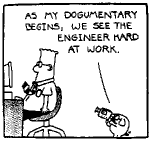
Dilbert and Dogbert © United Features Syndicate, Inc. |
I expect everyone who reads this is at least vaguely familiar with the comic strip
"Dilbert" by Scott Adams, about an electrical engineer and his dog. It's published
in about 2000 newspapers worldwide and related products like t-shirts, coffee mugs
and desk calendars are being sold just about everywhere.

Savage Dragon © Erik Larsen |
A lot less famous but immensely popular among its fans is the comicbook "Savage
Dragon", written, pencilled and inked since 1992 by its creator Erik Larsen.
This book revolves around a green, super-strong crimefighter with a fin on
his head.
Without getting into details about what makes the book special, if
you think of Marvel's "Spider-Man" or "X-Men" as soft drinks and Frank
Miller's "Sin City" as hard liquor, "Savage Dragon" is the beer of
comicbooks. (I actually don't drink beer, but this isn't a perfect metaphor.
Perhaps I should have said Schweppes.)
If there is a common theme to Dilbert and Savage Dragon, it's that they assume
(sometimes too optimistically) that the reader is neither easily offended, nor
a complete idiot. In today's world this can be quite refreshing.
 |
 |
 |
 |
| Brainiape, Savage Dragon and Hitler's Brain © Erik Larsen,
Hellboy © Mike Mignola |
One of the more original villains in the book is a gorilla with a human brain
floating in a bowl on top of its head. It was later revealed that the brain used
to belong to Adolf Hitler and that it has mutated to a point where it can talk,
move around on its own (with little stem arms and legs) and manipulate objects
telekinetically.
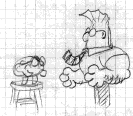
My first and incredibly lousy Savage Dragonbert sketch, late summer of
1998 |
It didn't take long until a twisted, absurd, perverted cross between my favorite
comic strip and my favorite comicbook formed in my mind: "Savage Dragonbert and
Hitler's Brainbert."
My initial thought was to draw just one picture and send it in to Savage
Dragon as fan art for the letters section, but then I reconsidered. This idea
had way too much potential to be blown on a single cartoon. Years of reading
Dilbert very thoroughly had left an imprint of Scott Adams' way of thinking
and I decided to draw some actual comic strips, to see if I could imitate the
special Dilbert humor and art, only with these new characters.
It wasn't difficult. Ideas emerged faster than I could put them on paper. Soon I
had 18 comic strips, which was a bit much for fan art. Everybody has a different
idea of what is really funny, so I mailed them anyway, together with a suggestion
that Erik Larsen should pick out the ones he liked best and discard the others.
Unfortunately, they were lost in the mail and never reached him.
The story could have ended there, but after a couple of months, having nothing
better to do at the moment, I scanned the strips and posted them on the on-line
Savage Dragon forum.
Instant success! Erik Larsen got wind of them and told me to mail him some new copies.
All the strips were printed, although spread out over several issues. Encouraged
by this, I kept sending in new strips and Savage Dragonbert was a part of
Savage Dragon from issue #57 up until #99, when I finally felt I had run out of
fresh ideas.
So, what does this Dragonbert look like? Well, shown below are the first
four strips of a mid-1999 zombie story. One of my favorites, as it happens.
Please note: satire legally constitutes
"fair use" and does not violate Mr. Adams' copyright. As for Mr. Larsen's part,
he prints the strips in his own book and I make no money on them, so I'm covered
there as well.

Satire won't work unless the reader has a bit of background knowledge of the subject
in focus. There is no way around that. Savage Dragonbert is a parody of
superhero comics in general. This is fine as long as you read a lot of those, but
otherwise the jokes are pretty much wasted. Below is one example.

Even though it doesn't take a genius to figure out that the fish are piranhas, it
helps a bit and gives the punchline its proper timing if you know that the superhero
Aquaman -- who usually gets along well with fish -- had his left hand eaten by
piranhas a few years ago. (It was a pretty big event. Ask any fanboy.)

Nothing strange about this one. It just advances the plot and helps prepare for the
next joke, which takes a swing at one of the biggest egos in the comics business.

His many talents aside, John Byrne has lately become infamous for fixing things
that "ain't broke" whenever he gets a chance to write his own scripts. The
most flagrant case was when he got called in to modernize the origin and first
years of Spider-Man to be more in tune with the '90s and bridge some of the
logical gaps. He spent 13 issues doing this and for the most part created
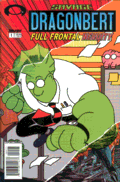 problems worse than the ones he had tried to solve. ("Retcon" is short for
"retroactive continuity", which is essentially history revisionism, except that
it's done to fiction, so history really does change.)
problems worse than the ones he had tried to solve. ("Retcon" is short for
"retroactive continuity", which is essentially history revisionism, except that
it's done to fiction, so history really does change.)
If you want to read more, you can buy all the collected material in the form of an
80-page comicbook, published by Image Comics in October 2002. It is titled
"Savage Dragonbert: Full Frontal Nerdity" and costs 5.95 USD. Though at this
point it might be hard to find.
 |
Savage Dragonbert: The Making of a Page
|
 |
The space I got for Savage Dragonbert was one page per month at first, with room
for four comic strips. To make the most of it, I tended to use either four totally
unrelated jokes or a complete story exactly four strips long. Failing that, I
tried to make the story exactly eight strips and split it onto two consecutive
issues. Later on I usually had two pages to work with, where eight strips
fit nicely, but I could squeeze in ten of them if I shrank things down a little.
Perhaps three or four cartoonists in the world are capable of coming up with
something genuinely funny each day. I'm glad I didn't have to work at that rate.
On average all I needed were one or two good jokes per week, which coincidentally is just what
I could manage. Perfecting a joke is a slow process. After getting an idea and
drawing an initial sketch I like to let the joke "age" for at least a month,
during which time I may change the punchline and re-write the dialog perhaps a
dozen times until I'm happy with it. If I still think it's funny after this,
then and only then is it worth keeping.
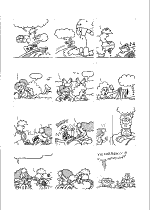 Unlike real comics pros I don't bother to draw the originals significantly larger
than what they will be in print. This wastes less time and paper -- and I can
work on inexpensive A4 sheets. Given the low required level of detail, I figure
I still don't lose any quality. Things would be different if I used my "own"
drawing style.
Unlike real comics pros I don't bother to draw the originals significantly larger
than what they will be in print. This wastes less time and paper -- and I can
work on inexpensive A4 sheets. Given the low required level of detail, I figure
I still don't lose any quality. Things would be different if I used my "own"
drawing style.
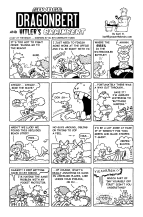 On the left is what a typical inked page looks like. I rarely bother to draw
panel borders and there is no text. Some strips may not be in the correct order,
if I happen to start with the ones that are easier to draw.
On the left is what a typical inked page looks like. I rarely bother to draw
panel borders and there is no text. Some strips may not be in the correct order,
if I happen to start with the ones that are easier to draw.
After scanning it in grayscale and blurring
it a little to eliminate scanner noise, I do a threshold operation and convert it
to black-and-white. Usually it needs some touching up and a few corrections where
I've fumbled with my pen.
When I'm satisfied I copy each panel onto a standard template I have prepared, with
12 empty panels and a logo. Once they are all in place I add the text and fill in
possible black areas, resulting in what you can see on the right.
The document is 2750 by 4175 pixels, at 400 dots per inch, and
ready for print. I simply e-mail it to the Art Director and that's that.
|





